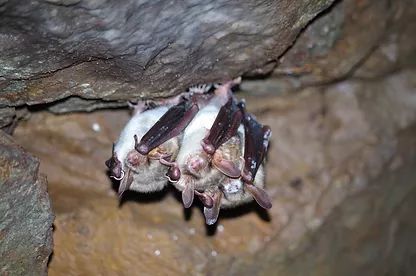Diseases can be a driving force in shaping the genetic structure of populations and even species, especially when the impacts affect particularly sensitive life stages. A prominent example of this process is white-nose syndrome, an infection caused by a fungal pathogen that affects bats during their hibernation. This mycosis has led to massive population declines in susceptible species in North America, particularly in bats of the genus Myotis.
In North America, Myotis species are affected by high mortality rates, while Myotis species in Eurasia exhibit remarkable tolerance to the infection. This could indicate a long co-evolution between the fungus and its bat hosts. In this context, the question arises: How do such diseases influence the genetic adaptation and evolution of species? With the existence of both susceptible and tolerant populations, white-nose syndrome provides a unique opportunity to unravel the factors contributing to tolerance at a genomic level. This can lead to a deeper understanding of the evolution of non-harmful host-parasite interactions.
To investigate whether the fungal disease has caused genetic adaptation in Eurasian bat species, we employed both whole-genome sequencing approaches and a comprehensive literature search. The goal was to compile a dataset of 300 genes to investigate signals of positive selection at the codon level in the genomes of 11 Eurasian bats. Our results show significant positive selection in 38 genes, many of which play a crucial role in responses to infections. These findings suggest that white-nose syndrome may have exerted significant selective pressure on Eurasian Myotis species in the past, contributing to their survival in coexistence with the pathogen.
The insights gained provide an understanding of the selective pressures that pathogens exert on their hosts. This methodology can also be applied to other host-pathogen study systems and offers important information about the evolutionary mechanisms that lead to tolerance to diseases. Exploring the interactions between pathogens and their hosts is crucial for understanding evolutionary processes and their impacts on biodiversity. By studying the adaptations of bats, we can derive important lessons about the adaptability and resilience of species in times of ecological change.
Overall, this investigation demonstrates how diseases can not only decimate populations but also act as catalysts for genetic changes and evolutionary adaptations. In a world where diseases increasingly influence animal and plant populations, it is essential to understand these dynamics in order to develop effective conservation and protection strategies.
Original study:
Twort, V. G., Laine, V. N., Field, K. A., Whiting-Fawcett, F., Ito, F., Reiman, M.,T. Bartonicka, M. Fritze, V. A. Ilyukha, V. V. Belkin, E. A. Khizhkin, D. M. Reeder, D. Fukui, T. L. Jiang Lilley, T. M. (2024). Signals of positive selection in genomes of palearctic Myotis-bats coexisting with a fungal pathogen. BMC genomics, 25(1), 828. https://doi.org/10.1186/s12864-024-10722-3

